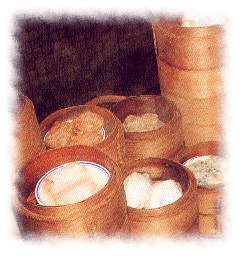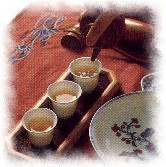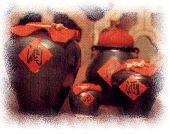Living & Values -- Food
The Chinese Philosopher Lao Tzu once said: "Governing a great nation is much like cooking a small fish." He meant that governing a country required just the right "seasonings" and adjustments for successful results. This metaphor clearly illustrates the significance that food occupies in Chinese culture!

|
In Chinese cooking, color, aroma, and flavor share equal importance in the preparation of each dish, thereby, satisfying the gustatory, olfactory, and visual senses. Any one entree will combine three to five colors, selected from ingredients that are light green, dark green, red, yellow, white, black, or caramel-colored. Usually, a meat and vegetable dish is prepared from one main ingredient and two to three secondary ingredients of contrasting colors. It is then cooked with the appropriate method, seasonings, and sauces to result in an aesthetically attractive dish. The primary methods of preparation include stir-frying, stewing, steaming, deep-frying, flash-frying, and pan-frying. A dish with a fragrant aroma will whet the appetite. Among many others, some ingredients that contribute to a mouth-watering aroma are scallions, fresh ginger root, garlic, chili peppers, wine, star anise, stick cinnamon, pepper, sesame oil, and dried black Chinese mushrooms. Of utmost importance in cooking any dish is preserving the fresh, natural flavor of the ingredients and removing any undesirable fish or game odors. In Western cooking, lemon is often used to remove smells of fish; in Chinese cooking, scallions and ginger serve a similar function. Soy sauce, sugar, vinegar, and other seasonings add richness to a dish without covering up the natural flavor of the ingredients. A well-prepared dish will be rich to those who like strong flavors, not over-spiced to those who like a blander taste, sweet to those who like a sweet flavor, and hot to those who like a piquancy. A dish that is all of these things to all of these people is a truly successful one.
Tradition
However, color, aroma, and flavor are not the only principles to be followed in Chinese cooking; nutrition is the first concern. A theory of the "harmonization of foods" can be traced back to the Shang dynasty's (16th to 11th century B.C) scholar Yi Yin. He relates the five flavors of sweet, sour, bitter, piquant, and salty to the nutritional needs of the five major organ systems of the body (the heart, liver, spleen, lungs, and kidneys), and he stresses their role in maintaining good physical health. In fact, many of the plants used in Chinese cooking such as scallions, fresh ginger root, garlic, dried lily buds, and tree fungus have properties of preventing and alleviating various illnesses. The Chinese have a traditional belief that food and medicine share the same origin and that food has a medicinal value. This view can be considered the forerunner of nutritional science in China. According to this theory, a correct proportion of meat to vegetable ingredients should be maintained. One-third of meat-based dishes should be made of vegetable ingredients, and one-third of vegetable dishes should consist of meat. In preparing soups, the quantity of water used should total seven-tenths the volume of the serving bowl. Basically, the correct ingredient proportions must be adhered to in the preparation of each dish or soup in order to ensure optimal nutritional value.
The Chinese have a number of traditional rules and customs associated with eating. For example, food must be eaten while seated. Also a set order of who may be seated first among men, women, old, and young exists. Furthermore, one must eat main courses with chopsticks and soup with a spoon.
The Present
In this cosmopolitan world, Chinese food is available in practically all major and many not-so-major-cities of the globe. In fact, in any large city or little village in China, you do not have to walk very far to find a restaurant. Even in home cooking, food is prepared with sophistication and variety. Northern style dishes include Peking duck, smoked chicken, chafing dish with sliced lamb, fish slices in sauce, beef with green pepper, and dried scallops with Chinese white radish balls. Representative of the Southern style of cooking are duck smoked with camphor and tea, chicken baked in salt, honey glazed ham, flash-fried shrimp, eggplant in soy sauce, and Szechwan style bean curd. With the rapid expansion of industry and commerce, a new twist has been added to traditional Chinese food: Chinese fast food franchises. At the same time, restaurants serving foods from all over the world have been springing up in the large cities of China: American hamburgers, Italian pizza, and Japanese Sashimi.
Drink
Tea
Wherever Chinese go, the custom of drinking tea follows. Tea was first discovered by the Chinese. Tea is an indispensable part of the life of a Chinese. A Chinese saying identifies the seven basic daily necessities as fuel, rice, oil, salt, soy sauce, vinegar, and tea. The custom of drinking tea has been ingrained in the Chinese for over a thousand years. During the mid-T'ang Dynasty (618-907 A.D.), a man named Lu Yu created the first compendium in the world on tea, the Tea Classic. This work helped to popularize the art of tea drinking all across China.

|
Tea drinking aficionados usually enjoy the beauty and feel of teapots. Small teapots are used to steep tea (in the "kung fu" steeping method). This particular method has been passed down to the present day from 16th century China, so it boasts a 400-year history. The full aroma and sweetness of the tea can be brought out when using a small teapot to steep tea.
Tea is China's national drink. It contains vitamins, tea derivatives, essential oils, and fluoride. It is a diuretic attributed with the properties of improving the eyesight and increasing alertness, so Chinese believe that frequent tea drinkers enjoy an increased life span. Its medical properties and benefits to the human body have actually been scientifically proven, and tea has come to be generally recognized as a natural health food.
Wine
The origins of fermenting and drinking wine in China go far back in time. The ancient Chinese either used wine as a libation to their forefathers to express reverence, enjoyed it by themselves while writing poetry or prose, or toasted their relatives and friends during a feast. Wine was intimately connected with most Chinese men of letters. Grains were used to ferment wine throughout ancient China. Thus, whether or not the grain harvest was bountiful became a criterion by which many governments decided whether to lift their ban on wine making or how heavy a wine tax to levy. Over the ages, wine gradually became directly linked to the daily life and tax burden of the people.

|
From wine making and drinking we can glimpse a bit of the wisdom of ancient Chinese. Wine was influential in the accomplishments of intellectuals. Policy measures prohibiting wine making and measures levying wine taxes illustrate certain links between wine and national taxes. Wine is an important segment of dietary culture, and its significance in Chinese culture should not be overlooked.



 Chinese Culture
Chinese Culture